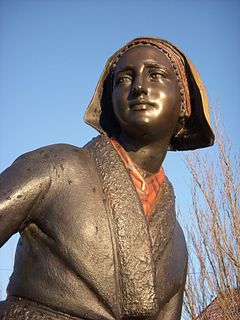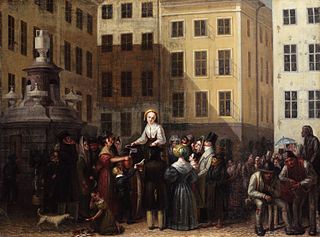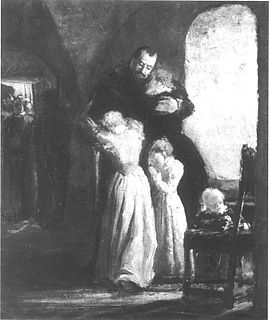
Anna Rheinholdsdotter Leuhusen (died c. 1554), was the Abbess of St. Clare's Priory in Stockholm. She became known for her involvement in the Swedish War of Liberation between Sweden and Denmark in the 1520s.

Anna Rheinholdsdotter Leuhusen (died c. 1554), was the Abbess of St. Clare's Priory in Stockholm. She became known for her involvement in the Swedish War of Liberation between Sweden and Denmark in the 1520s.
Anna Leuhusen was born the child of Reinhold Leuhusen, merchant in Stockholm, and the sister of Martin Leuhusen, who is listed as a member of the city council of 1521; Martin Leuhusen was a fervent Catholic who did not convert until 1536. Her sister was married to the Danish colonel Gregorius Holst. The year of her birth is unknown. Anna Lehusen entered the Clara Abbey as a member of the order of Saint Clare of Assisi. She was appointed abbess sometime prior to 1508. This year, she is confirmed as such, when she appealed to the city for economic assistance in her capacity of abbess.
During this period, Sweden and Denmark, formally united through the Kalmar Union, was involved in various warfare which eventually led to the Swedish War of Liberation. In 1520, the city of Stockholm was sieged and taken by the Danes after the defeat of Christina Gyllenstierna. Soon after, however, the rest of Sweden rose in rebellion and in 1522, the city was besieged by the Swedes under Gustav Vasa. During the siege, the St. Clare's Priory was used as an escape channel by people who wished to join the Swedes outside the city, both merchants and courtiers.
Leuhusen was a Danish loyalist and, according to the legend, responsible for betraying several of these people. During the day, she signaled by hanging a white cloth out of the window and, during the night, a lamp to the part of the convent facing the city, as a sign to the Danes that there were refugees in the building. When they left the convent on their way outside the city, they were taken by the Danes and executed for treason. This was performed in collaboration with her brother-in-law, the Danish loyalist mayor of Stockholm. [1]
In June 1523, Stockholm was retaken by the Swedes and made capital of the independent Kingdom of Sweden. In 1525, Elin Thomasdotter is noted to have replaced Anna Leuhusen as abbess. The St. Clare's Priory was one of the first convents to be dissolved during the Swedish Reformation in 1527. This has been contributed to the acts of Anna Leuhusen during the war, for which the King felt vengeful. [2] Former Abbess Anna Leuhusen and the rest of the nuns was allowed to settle in the dissolved Grey Friar Abbey, which had been left empty by the monks, where they worked as nurses the rest of their lives.
Anna Leuhusen is known to have kept one of the convent most treasured possessions. When the abbey was founded in 1288, Princess Richenza of Sweden had entered it, and became its abbess in 1335. Richenza possessed a golden chain, which was consequently used by the abbesses of the abbey for centuries. Anna Leuhusen kept this chain when the abbey was dissolved and gave it to her family.
Anna Leuhusen was still alive in 1550. She is believed to have died around 1554.

Ulrika Eleonora or Ulrica Eleanor, known as Ulrika Eleonora the Younger, was Queen of Sweden, reigning in her own right from 5 December 1718 until her abdication on 29 February 1720 in favour of her husband King Frederick, and then as his consort until her death.

Princess Sophia Albertina of Sweden was the last Princess-Abbess of Quedlinburg Abbey, and as such reigned as vassal monarch of the Holy Roman Empire.

The Abbey Pax Mariae, more commonly referred to as Vadstena Abbey, situated on Lake Vättern in the Diocese of Linköping, Sweden, was the motherhouse of the Bridgettine Order. The abbey started on one of the farms donated to it by the king, but the town of Vadstena grew up around it. It was active from 1346 until 1595.
Women have played a leading role in active warfare. The following is a list of prominent women in war and their exploits from about 1500 up to about 1699.

Christina of Saxony, was Queen of Denmark, Norway and Sweden as the wife of King John.

Helga de la Brache, née Aurora Florentina Magnusson,, was a Swedish con artist. She obtained a royal pension by convincing the authorities that she was the secret legitimate daughter of King Gustav IV of Sweden and Queen Frederica of Baden.

St. Clare's Priory, Stockholm, was a Roman Catholic nunnery of the Poor Clares in Stockholm, Sweden that was active from 1289 to the Swedish Reformation in 1527.

Sven Stolpe was a Swedish writer, translator, journalist, literary scholar and critic. His brother was Herman Stolpe. Sven Stolpe was active in Swedish literary and intellectual discussion for most of his life. In the early 1930s, he argued for internationalism and argued against aestheticism, but he was also part of the Oxford Group which claimed the necessity of "moral and spiritual re-armament" and later in life, in 1947, he became a Catholic. Among his literary production is a dissertation on Queen Christina of Sweden, who abdicated as a result of her own conversion to Catholicism, which was published in 1959.

Countess Maria Aurora von Königsmarck was a Swedish and German noblewoman of Brandenburg extraction and mistress of Augustus the Strong, Elector of Saxony and King of Poland.

Pilt Carin Ersdotter (1814–1885), was a Swedish milkmaid from Djura in Dalarna who became famous for her beauty. She sold milk on the street of Stockholm in 1833-1834, and attracted so much attention that she became a mascot to be displayed in the salons of the aristocracy for money. Being a girl from Dalarna, she was called "dalkulla" and known as "Vackra dalkullan".

Ragnhild Grågås was a 15th century resident of Stockholm, Sweden. She was the person after whom Gåsgränd in Gamla stan was named.

Carolina Lindström, née Lundström (1812–1892), was a Swedish miliner. She was known in Stockholm as "Evening Star", because she was often seen working during the night.

Beata Rosenhane was a Swedish Baroness and writer. She was known for her learning and received an education unusual for a female of her epoch, and has as such been the subject of research.
St. John's Priory, Kalmar, commonly known simply as Kalmar Nunnery, was a Roman Catholic convent for women of the Dominican Order in Kalmar in Sweden, in operation from 1299 until 1505.

Skänninge Abbey, also known as St. Ingrid's Priory, St. Martin's Priory or Skänninge Nunnery, was a Roman Catholic convent for females of the Dominican Order in Skänninge in Sweden, in operation from 1272 until 1544. It was founded by Saint Ingrid of Skänninge, and the center of her cult, and as such, it was often referred to as St. Ingrid's Priory. Located near the church dedicated to Martin of Tours, it was originally named St. Martin's Priory, though this name was rarely used in practice. The common name for it was Skänninge Abbey, but as there was also a convent for male members of the Dominican Order in Skänninge, it was often called Skänninge Nunnery to separate it from the male monastery.

Events from the year 1833 in Sweden

Sigrid Gustafsdotter Banér, was a Swedish noble, letter writer and Scholarship founder. She is most known in history for the letters to her sister Anna, in which she describe the last days of her father Gustaf Banér, who was executed during the Linköping Bloodbath.
Marienbrunn Abbey also called Fons Mariae and Triumphus Marie was a double convent for women and men of the order of the Bridgettines, situated in Gdańsk between 1391 and 1833. It was the first convent of the order founded outside of Sweden, and the second convent of the order altogether.
Anna Germundsdotter or Girmundsdotter was a Swedish writer and Roman Catholic nun of the Bridgettine order and abbess of the Vadstena Abbey from 1518 until 1529.
Leuhusen is a Swedish baronial family. Members include: